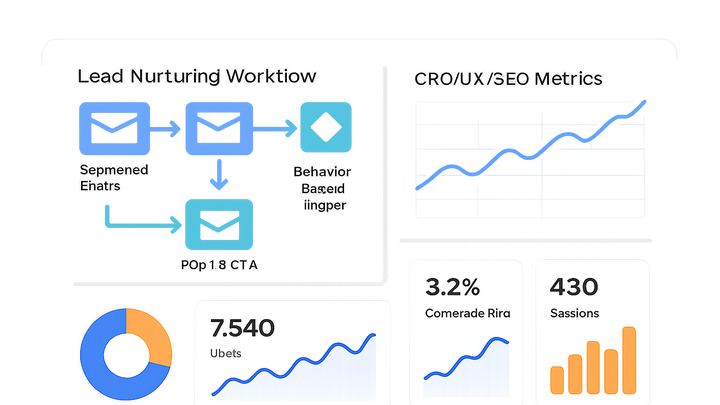Published on 2025-06-29T20:05:30Z
What is Lead Nurturing? Examples for Lead Nurturing
Lead nurturing is the strategic process of engaging and guiding potential customers through the buyer’s journey by delivering relevant, timely content and experiences. In the context of CRO, UX, and SEO, effective lead nurturing combines personalized messaging, behavioral triggers, and SEO-friendly content to convert prospects into customers. Tools like Prevue.me can automate critique-based triggers—analyzing CRO, UX, SEO, and accessibility insights—to deliver targeted calls-to-action and follow-up campaigns. Key benefits include improved conversion rates, enhanced user experience, and stronger SEO performance.
Lead nurturing
Engaging and guiding prospects with targeted, timely content and multi-channel touchpoints to convert site visitors into customers.
Why Lead Nurturing Matters in CRO/UX/SEO
Lead nurturing bridges the gap between first interaction and final conversion by continuously engaging prospects. It aligns conversion rate optimization, user experience, and SEO goals to drive meaningful engagement at every stage of the funnel.
-
Increased conversions
Nurturing warms up leads over time, boosting the likelihood of conversion by delivering value and building trust.
-
Enhanced user experience
Personalized content and timely touchpoints improve satisfaction and guide users seamlessly through the site.
-
Seo improvements
Engaged visitors spend more time on site and explore deeper, sending positive signals to search engines.
- Reduced bounce rate:
Engaging content keeps visitors exploring rather than leaving immediately.
- Increased dwell time:
Quality nurturing content encourages deeper interactions and page views.
- Reduced bounce rate:
Core Components of Effective Lead Nurturing
Successful lead nurturing relies on strategic segmentation, personalized content, automated workflows, and consistent multi-channel engagement.
-
Audience segmentation
Divide leads into groups based on demographics, behavior, and engagement to tailor messaging.
- Behavioral segmentation:
Segment leads by actions like page visits, clicks, and resource downloads.
- Demographic segmentation:
Segment by role, industry, company size, and geographic location.
- Behavioral segmentation:
-
Personalized content
Craft messages and offers that address specific needs and pain points of each segment.
-
Automated workflows
Set up sequences triggered by lead behavior—site visits, form submissions, or content downloads—to deliver timely messages.
- Trigger events:
Define specific actions that launch email sequences or on-site messages.
- Drip sequences:
Schedule a series of emails or notifications to guide leads through the funnel.
- Trigger events:
-
Multi-channel touchpoints
Engage leads across email, on-site messages, chatbots, SMS, and social retargeting to reinforce messaging.
Implementing Lead Nurturing with Prevue.me
prevue.me provides real-time website critiques across CRO, UX, SEO, and accessibility. Use its insights to trigger lead nurturing actions and optimize campaigns.
-
Website critique trigger setup
Use prevue.me to analyze visitor behavior and content engagement, then automatically trigger personalized CTAs or email sequences.
-
Custom cta personalization
Leverage prevue.me’s segment data to display dynamic calls-to-action tailored to user intent and device type.
-
Automated follow-up campaigns
Integrate prevue.me insights with email automation to send targeted sequences based on critique results.
-
Continuous optimization
Regularly review prevue.me reports to refine content, messaging, and workflow triggers for ongoing improvement.
Best Practices for Lead Nurturing
Adopt these best practices to maximize engagement, maintain SEO integrity, and ensure accessibility throughout your lead nurturing strategy.
-
Leverage data for optimal timing
Monitor user activity to schedule messages when engagement likelihood is highest.
-
Align content with seo and accessibility
Use SEO-friendly headings, meta tags, and accessible design to ensure all users and search engines can benefit.
- Use semantic html:
Structure content with proper headings, lists, and ARIA roles for screen readers.
- Optimize meta tags:
Include target keywords in titles and descriptions to improve discoverability.
- Use semantic html:
-
Test and iterate
A/B test subject lines, content variations, and channels to identify what drives the best engagement.
